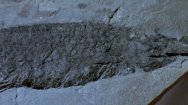 Description:
This lungfish fossil comes from the area around Caithness, Scotland
that is famous for Devonian fishes. The genus Dipterus was also
the first lungfish to described in the fossil
record, circa 1828,
notably by Adam Sedgwick (considered by some as a founder of
modern geology) and Roderick Murchison, another early geologist. Description:
This lungfish fossil comes from the area around Caithness, Scotland
that is famous for Devonian fishes. The genus Dipterus was also
the first lungfish to described in the fossil
record, circa 1828,
notably by Adam Sedgwick (considered by some as a founder of
modern geology) and Roderick Murchison, another early geologist.
The
lungfish appear in the fossil record in the early Devonian,
then radiated reaching maximum diversity by the end of the period.
Early members of subclass Dipnoi were  marine fish, while all
those in the fossil record from Carboniferous lived in fresh
water. marine fish, while all
those in the fossil record from Carboniferous lived in fresh
water.
Lungfish
along coelacanths are the jawed, lobe-finned and (mostly) bony
fish that together with the tetrapods (amphibians, reptiles,
birds and mammals) comprise Class Sarcopterygii.
Lungfish are
thus in the important lineage that would colonize and dominate the land, including
humans, of course. Dipterus had lungs but no air bladder, as in still
extant lungfishes; in contrast, its dorsal, caudal, and anal fins were separated,
unlike modern descendants where they are fused together. Unique
to these early lobe-finned fish were cosmoid scales that had shiny
bony tissue that due to an external enameloid layer over a dentine
layer and which
had a vascular system. Fossils sometimes retain shininess due to this. Not
surprisingly, the lobe-finned fish had numerous morphological characteristics
that fostered
land colonization, many of which have been throughout the evolution of land
vertebrates. Sarcopterygii.
Lungfish are
thus in the important lineage that would colonize and dominate the land, including
humans, of course. Dipterus had lungs but no air bladder, as in still
extant lungfishes; in contrast, its dorsal, caudal, and anal fins were separated,
unlike modern descendants where they are fused together. Unique
to these early lobe-finned fish were cosmoid scales that had shiny
bony tissue that due to an external enameloid layer over a dentine
layer and which
had a vascular system. Fossils sometimes retain shininess due to this. Not
surprisingly, the lobe-finned fish had numerous morphological characteristics
that fostered
land colonization, many of which have been throughout the evolution of land
vertebrates.
 The
Sarcopterygii lobe-finned fishes and ray-finned fishes (Class
Actinopterygii) both became common during the Devonian “Age
of Fishes”.
However, essentially all jawless fishes (Superclass Agnatha) excepting
lampreys and
hagfish, as well as the Placodermi armored fishes disappeared by the end of
the Period. Extant lungfish are now only found in Africa, South America and
Australia, so they continue their long run. The
Sarcopterygii lobe-finned fishes and ray-finned fishes (Class
Actinopterygii) both became common during the Devonian “Age
of Fishes”.
However, essentially all jawless fishes (Superclass Agnatha) excepting
lampreys and
hagfish, as well as the Placodermi armored fishes disappeared by the end of
the Period. Extant lungfish are now only found in Africa, South America and
Australia, so they continue their long run.
Also
see: Paleobiology-Devonian
Evolutionary Milestones Sarcopterygii
Fish Fossils |





